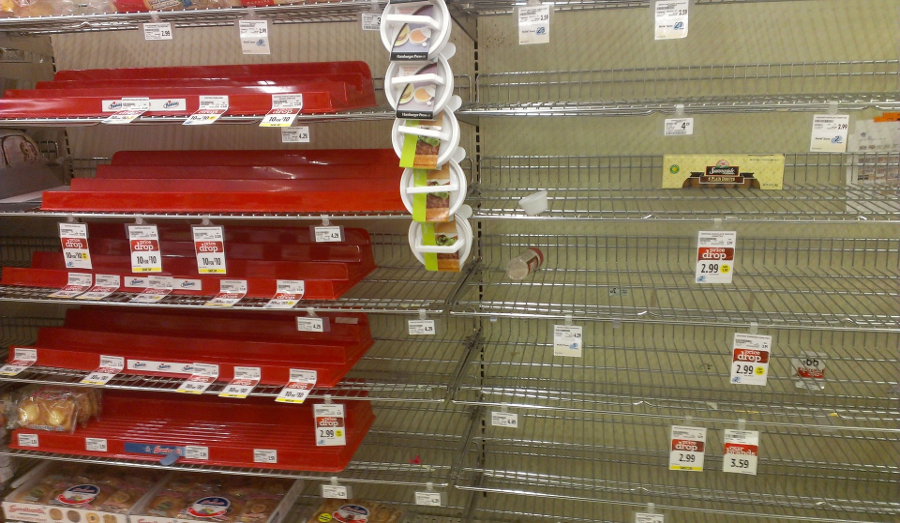If you’re looking to store goods for a survival or disaster scenario, you may be overwhelmed by all the things you’ll want to stock up on. But one guiding principle that can help you is to think about which goods will disappear from store shelves first.
Just think about pictures and videos you’ve seen of grocery store shelves prior to a snowstorm, hurricane, or some other natural disaster. Some goods are emptied from shelves quicker than others, and those are the ones you’ll want to make sure you’re stocked up on. Here are just a few of them.
Edibles
1. Bread
Bread is one of the first items to empty from shelves, but it has a limited shelf life. You can freeze bread to store it for long-term use, but that takes up valuable freezer space. If you’re confident that you’ll have the ability to bake in a survival situation, you can stock up on flour instead.
2. Milk
Milk also leaves store shelves quickly, but it too has a short shelf life. Think about supplementing fresh milk with condensed milk, ultra-pasteurized milk, or powdered milk.
3. Water
You should have water stocked up already, but if you don’t, make sure that you have at least one gallon per day stored up for every person in your household. If your home’s water is supplied by a water pump or a well that relies on electricity, you won’t be able to rely on your taps for water when power goes out. Make sure that you have water available that will stand up to long-term storage.
4. Canned Food
You may think that you can run down to the store and pick up canned tomatoes, beans, vegetables, tuna, or meat. But those cans will fly off the shelves before a storm. If you often use canned food, make sure to have multiple cans on hand at any given time.
5. Rice & Beans
Rice and beans are a complete meal that can give you all the protein you need. Whether you use dried beans or canned, make sure you have plenty of rice and beans stored up.
6. Cooking Oils & Fats
Fats are necessary for survival from an energy perspective. They’re also necessary for cooking and baking. Butter needs to be stored in the refrigerator or freezer, but other oils and fats are more shelf-stable. Make sure you have plenty of oil and fat stored so that you don’t run out when you need it most.
7. Vegetables
Fresh vegetables are one of the quickest things to disappear from store shelves. They also have a limited shelf life, so you’re not going to be able to stock up on huge amounts of them. Blanch and freeze whatever you can, make sure you have canned vegetables so that you can still get vital vitamins and minerals, and grow your own if you have the space for it.
8. Meat
Meat also is perishable, and any meat on store shelves will disappear quickly. For long-term storage you’ll need to freeze it, either in your refrigerator freezer or in a chest freezer. That means that you’ll want to have a generator to power your freezer lest you risk losing huge amounts of meat to spoilage if the power goes out.
Non-Edibles
1. Toilet Paper
You would think that most people have a good supply of toilet paper at home, but apparently not. Toilet paper is one of the first things to disappear from shelves. Buying it in bulk ahead of time not only is cheaper, but it also ensures that you have toilet paper available when it disappears from store shelves.
2. Baby Supplies
If you have a baby or a toddler, you’ll want to make sure that you have plenty of diapers, wipes, formula, rash cream, etc. You may not be able to make it to the store for weeks, so unless you have enough supplies at home, you’ll be out of luck.
3. First Aid Supplies
You never know what kind of injuries you’ll have to treat, so make sure that you have plenty of first aid supplies on hand. Topical antibiotics, band-aids, gauze, etc. will disappear from stores, so make sure your home first aid kit is stocked up.
4. Over the Counter Medication
Painkillers like aspirin, ibuprofen, Tylenol, etc. will get snatched up quickly too. Make sure to have plenty at home, as well as any other medications you may need, such as anti-diarrheals, anti-gas medication, etc.
5. Personal Hygiene Supplies
If you buy your soap a bar at a time, you may be out of luck if you run out during a disaster scenario. Make sure to have plenty of liquid and bar soap on hand, as well as shampoo, skin cream, deodorant, and any other personal hygiene products you use.
6. Plastic Bags
Plastic bags will be in high demand during a survival scenario, not just for bagging trash but also for waterproofing personal goods, sealing broken windows, etc. Don’t wait until you really need them to stock up, make sure you have several dozen on hand at any given time.
7. Brooms, Rakes, and Shovels
During summertime you’ll need brooms and rakes to clean up, and during wintertime you’ll need snow shovels. Tools like that last for years or decades, so buy them now to make sure you’ll have them when you really need them.
8. Tape, Nails, Glue, Screws
As well as having bags, you’ll need some way to seal them or attach them. Make sure to have plenty of tape, nails, glue, and screws on hand, both to close up or hang bags as well as to attach pieces of wood or plywood wherever is necessary.
9. Batteries
Whether you need batteries for a flashlight, a radio, or some other electronic device, you won’t be able to find them on the shelves during a disaster or survival situation. Buy them ahead of time, buy in bulk to save money, and store them properly so that they’re still fresh when it comes time to use them.
This article was originally posted on Red Tea News.





